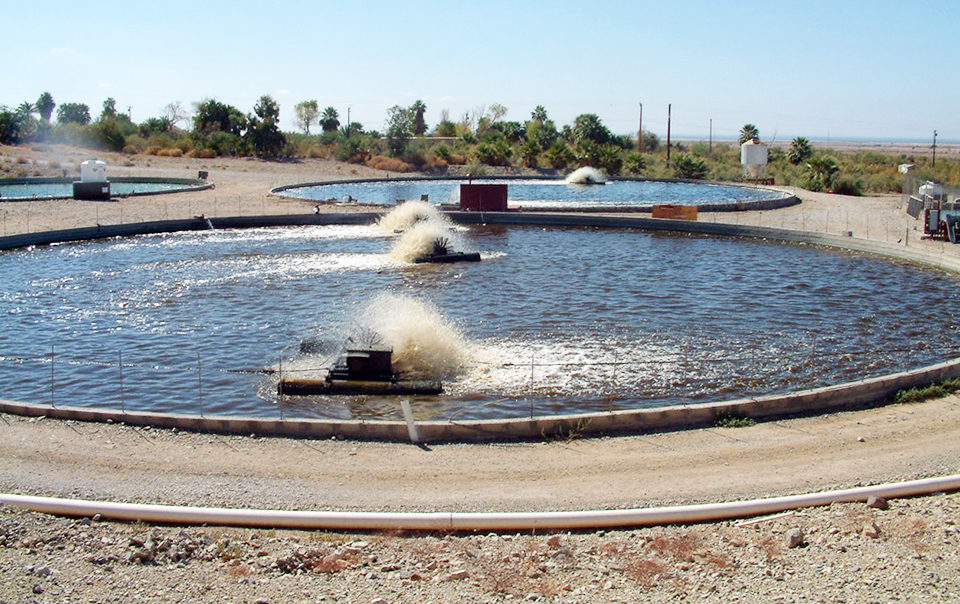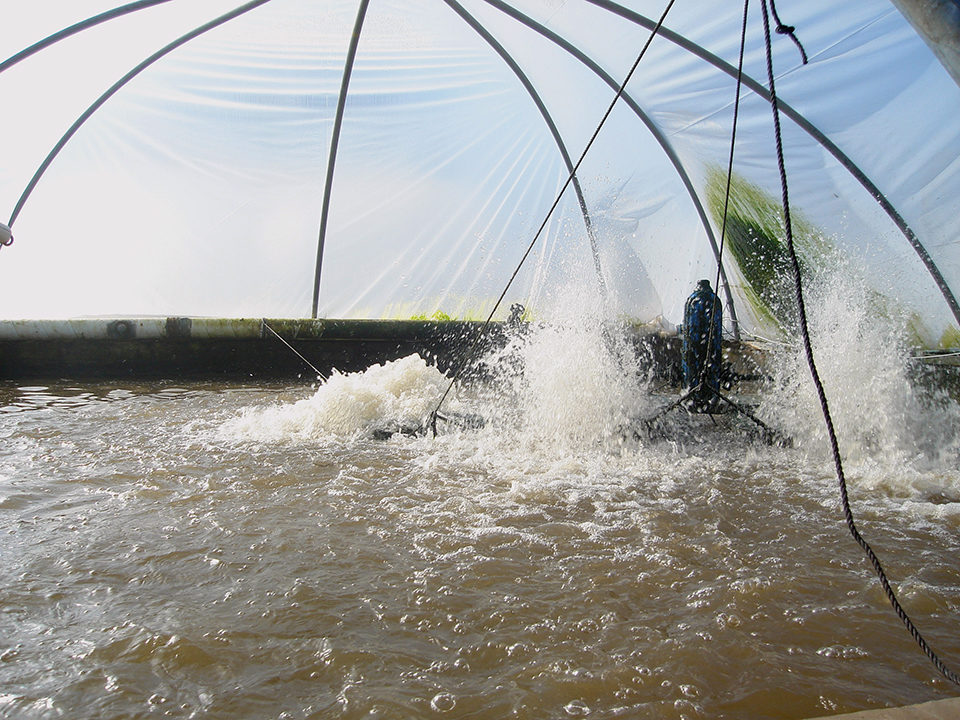Saving water, waste recycling improves economics

Production of tilapia has risen tremendously in the last few decades. At about 3 mmt in 2010, the volume of worldwide tilapia production was second only to carps among fish. Current trends indicate a continuous growth of production and expanded penetration of tilapia in a variety of markets, from expensive restaurants to local households all around the world.
Although higher production levels are needed, increased aquaculture production is limited globally by the availability of suitable water and land. The most feasible and environmentally acceptable way to raise aquaculture production is by the use of intensive production systems.
Biofloc technology
One of the systems that enable intensification at a relatively reasonable investment and operating cost is biofloc technology.
Biofloc technology is based upon pond management using minimal water exchange and subsequent development of dense microbial populations. The microbes are managed through the adjustment of the carbon:niotrogen (C:N) ratio to control inorganic nitrogen concentrations in the water.
The bacteria that form bioflocs assimilate total ammonia nitrogen (TAN), produce microbial proteins and enable recycling of unused feed protein. Biofloc systems are widely used for shrimp production.
Tilapia and bioflocs
Tilapia are ideally adapted to biofloc systems. The filter-feeding herbivores adapt to the harvest of bioflocs suspended in the water, and the strong, stable fish grow and flourish in dense systems.
An essential feature of biofloc tilapia production systems, especially as compared to shrimp systems, is the very high biomass. In the author’s experience, tilapia biomass can reach 200-300 mt/ha, as compared to shrimp biomass of about 20 mt/ha in well-managed ponds. This difference is a very significant feature for minimal water exchange. The high fish density, however, generates wastes at high rates.
TAN control
The daily TAN release, if untreated and left in the water, is high enough to lead to fish mortality. Two microbial mediated processes act in biofloc systems to control TAN concentrations.
The first process is the assimilation of TAN by heterotrophic bacteria into microbial protein. In systems with higher levels of available carbon than nitrogen (C:N ratio above 15), bacteria utilize the carbon as a building block for new cell material. However, since microbial cells are made of protein, they need nitrogen and take up ammonium from the water. Both experience and theory demonstrate that when C:N is higher than 15, TAN concentrations are kept low.
The second microbial process is nitrification that converts the toxic ammonia and nitrite to nitrate. It is important to note that both processes can take place only if the proper microbial consortia are present in sufficient levels in the water. The heterotrophic consortia develop rather quickly following the build-up of organic matter in the water. The nitrifying community develops slowly and takes about four weeks to reach its capacity, unless a proper inoculum is applied.
Microbial assimilation of nitrogen is, as mentioned, a high-capacity mechanism that controls nitrogen and especially TAN levels in water. Microbial protein produced concomitantly can serve as a high-quality feed source for fish. In biofloc microbial systems, where bacterial density can reach 1 billion cells/mL, the bacteria stick together with other organisms and organic particles to form bioflocs whose particles range in size from 0.1 to a few millimeters. Such particles are easily harvested and assimilated by tilapia.
Suspended solids
Total suspended solids (TSS) or biofloc volume quickly accumulate in ponds when fish biomass is high. The desired microbial community and reserves of feed should not be released carelessly, but excessive levels of TSS add to oxygen consumption and at very high levels can clog the gills of fish.
In addition, if water is not well mixed or TSS concentrations exceed the mixing capacity of the system, solid particles settle downward and can accumulate in anaerobic soil layers or pockets. Anaerobic sites in pond bottoms can lead to the production of toxic reduced compounds and eventually severely hamper fish growth.
TSS levels can be controlled by drainage of sludge, proper water mixing and good pond bottom design.
Protein in bioflocs
The amounts of protein stored in bioflocs are very significant. If only 50 percent of the TAN excreted by tilapia is assimilated and available as a fish feed, this process can add an amount of protein equivalent to feeding with 30 percent-protein pellets at a daily ration of 150 g/m3. Moreover, unlike the applied feed, bioflocs can be utilized by the fish continuously.
In comparing the feeding behavior of tilapia growing in a biofloc pond with tilapia in equivalent control ponds that received feed twice a day, fish in the control ponds were very hungry and rushed wildly to the floating feed pellets, while tilapia in the biofloc ponds ate quietly, showing they were not starved before feeding. It may be expected that the semi-continuous feeding available with bioflocs would help smaller fish compete with larger fish for food and thus achieve higher uniformity in size.

Feeding
Feeding is an important control in achieving the proper C:N ratios that promote the uptake of ammonium from the water. In addition, effective feed strategies enable fish to utilize the recycled microbial protein, reduce costs and minimize residues. There is a need for more research on optimized feed composition and ration.
The recommended C:N ratio can be obtained by feeding with pellets of low protein content or by augmenting the feed pellets through the application of carbonaceous material such as molasses, cassava, wheat or other flours. The first option may save labor. However, the author’s facility relies upon the passage and excretion of the added carbohydrates through the fish to be used by the bacteria. This assumption may not hold.
Feed rations can be lower than those used in conventional tilapia ponds. With shrimp in tanks, it was found that feed rations could be reduced 30 percent lower than the rates used in conventional systems. It was estimated, but not proven, that feed rations in biofloc tilapia systems can be lowered at least 20 percent from conventional system levels.
Molasses is readily soluble and its addition to ponds is rather simple. Adding flour demands more effort in dispersal. Using a mixer in a container outside the pond to create a suspension, rather than the dry flour that tends to cake in the pond, can assist the process.
Oxygen management
Oxygen consumption in intensive biofloc tilapia culture is rather high due to the respiration of the high fish biomass as well as the microbial community that metabolizes the organic residues. Oxygen consumption has been estimated or modeled by several scientists.
Biofloc tilapia ponds tend to be rather small – 100 to 1,000 m2 – mostly due to difficulties in thoroughly mixing the water within larger bodies. Most ponds are round or square with rounded corners. The pond floors usually slope toward the center to facilitate concentration and daily removal via a drain.
The range of required aeration is 10 to 20 hp for a pond of 0.1 ha. However, the exact aeration rate needed for a given pond should be adjusted following the daily determination of oxygen levels in the pond, with a normal minimal level of 4 mg oxygen/L. One should adjust aerator usage to the size of the fish and pond biomass. Farm operators can usually use lower aeration at the start of the production cycle, although it is recommended to utilize the capacity of the pond by stocking large numbers of fingerlings and maintaining a relatively constant biomass by appropriate transfers.
Proper placement of aerators is very important. Most pond aeration is deployed to obtain a circular movement of water that concentrates settled particles as close as possible to the center drain, usually using paddlewheel aerators. However, there are conflicting demands in this matter.
We want to be able to effectively drain excess sludge, yet keep bioflocs suspended in the water. To prevent overly effective sedimentation of particles near the center drain, it is advisable to position an aspirator aerator or airlifts to resuspend particles near the pond center. By properly adjusting the location of these units, optimal resuspension of the less-dense bioflocs and sedimention of the heavier particles can be achieved.
A very important requirement is to have a sensitive and reliable monitoring and backup system. Aeration failure at high fish biomass can be critical if backup is not activated within an hour.

Monitoring
Although biofloc tilapia ponds are rather simple to operate, they demand careful monitoring and fast response to any problems detected. Since the ponds are so highly loaded, any fault not responded to can become critical. Normal aquaculture monitoring is certainly needed. Of special importance are the following parameters:
- Oxygen. If oxygen is high, you can reduce the number of applied aerators to save electricity. However, if oxygen levels are less than 4 mg/L, add aerators.
- Total ammonia nitrogen. TAN concentrations below 0.5 mg/L mean the system is working well. You may consider adding less carbon. If TAN increases, respond quickly with carbon supplementation.
- Nitrite. Nitrite can negatively affect tilapia, although its effects are limited in salty water. However, an increase in nitrite can indicate the build-up of anaerobic sites. In the case of an increase of nitrite, carefully check for sludge piles and, if found, change aerator deployment.
- Floc volume. Determination of floc volume using Imhoff cones is easy and cheap. Floc volume should be in the 5-50 mL/L range. If it is too low, add carbohydrates, and if it is higher than 50, increase sludge removal.
(Editor’s Note: This article was originally published in the May/June 2011 print edition of the Global Aquaculture Advocate.)
Author
-
Dr. Yoram Avnimelech
Department of Civil and Environmental Engineering
Technion, Israel Institute of Technology
Haifa, Israel 32000
Related Posts

Aquafeeds
Biofloc and clear-water RAS systems: a comparison
This study compared two types of indoor, shrimp culture systems: clear-water RAS and biofloc systems. Clearwater RAS had the edge in water quality, but shrimp in the biofloc treatment had a higher feed conversion ratio.

Aquafeeds
Biofloc consumption by Pacific white shrimp postlarvae
The stable isotopes technique with δ13C and δ15N can be used to determine the relevance of different food sources to shrimp feeding during the pre-nursery phase of Litopenaeus vannamei culture. During this trial, different types of commercial feed, microalgae, Artemia sp. nauplii and bioflocs were used as food sources.

Aquafeeds
Biofloc systems viable for tilapia production
Well-designed and managed biofloc technology systems are a viable alternative for production of various species like tilapia, to increase feed efficiency by lowering aquafeed protein requirements and to help reduce or eliminate effluent discharges.

Health & Welfare
Biofloc technology holds potential for carnivorous fish species
Juvenile carnivorous African catfish performed well in biofloc-based systems, which could help produce better quality and more disease-resistant seed of this important aquaculture species and support the expansion of African catfish farming industry.


